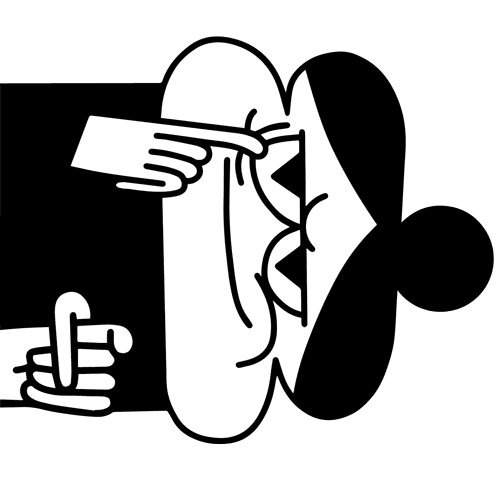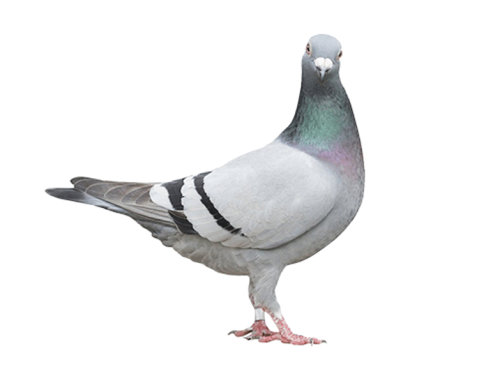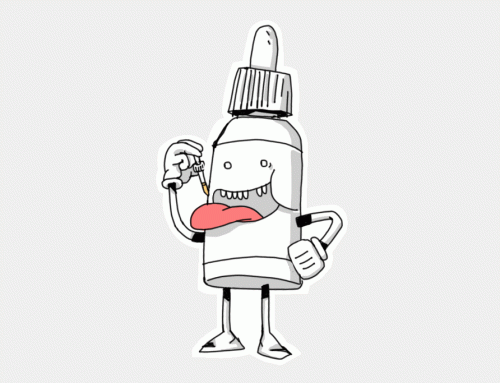Karma, the TMB’s new mascot or what goes around comes around on the underground.
You might have seen it, underground, lurking in the metro. it leers at you from trashcans, turnstiles, ceilings, and billboards. it pops up on the seat opposite you admonishing “ei, seient reservat” – the seat’s taken. you tell yourself that you weren’t going to sit there anyway, that you were going to leave it open for those in need. or were you? as the metro speeds on, karma issues more warnings on the windows: “ei, et veig” and “tot torna”.
 Karma is a lanky, wide-eyed, black-and-white cartoon character and the star of TMB’s new campaign to promote a better you in a more civilized population. In essence, over the course of the next three years Karma will be telling us, “Don’t be a jerk.” Give up your spot to those who need it more than you, don’t put your feet up, and pay for your ride like everyone else. The campaign and its new mascot were launched at the beginning of this year with the help of ad agency BUM, artist Juan Díaz-Faes and graphic design firm The Mushroom Company, and rely on the concept of karmic justice: what goes around comes around. TMB chose the campaign’s leitmotif because BUM’s research has shown that many Barcelonans not only recognize karma but also believe in it. So there you have it, xiquets: tot torna!
Karma is a lanky, wide-eyed, black-and-white cartoon character and the star of TMB’s new campaign to promote a better you in a more civilized population. In essence, over the course of the next three years Karma will be telling us, “Don’t be a jerk.” Give up your spot to those who need it more than you, don’t put your feet up, and pay for your ride like everyone else. The campaign and its new mascot were launched at the beginning of this year with the help of ad agency BUM, artist Juan Díaz-Faes and graphic design firm The Mushroom Company, and rely on the concept of karmic justice: what goes around comes around. TMB chose the campaign’s leitmotif because BUM’s research has shown that many Barcelonans not only recognize karma but also believe in it. So there you have it, xiquets: tot torna!
TMB first unveiled Karma at their employee Christmas Party. Santiago explains that while the idea was imagined as a surprise for public transport users, it was best not to spring it on the 8,000 TMB workers, “almost the size of a city,” he jokes. Most of the Karmas we see now, vinyl stickers festooning turnstiles, tunnel walls, wastebaskets, platform doors, and bus exteriors, are from phase one of the campaign, which ran through January. In February phase two introduced the character in animated shorts on TMB screens. Santiago Torres Sierra, the TMB director of communications knows the message they give out on the Metro megaphone system by heart and he gladly recites it: “Viatjar amb karma és gaudir del viatge, és respectar el que és de tothom, és donar preferència a les persones grans o als que viatgen amb la mobilitat reduïda. Viatjar amb karma és viatjar amb respecte i en bona convivència. Així viatgem millor. Amb TMB, bon viatge i bon karma!”
Karma is a barceloní for the barcelonins, thought up primarily for a local audience. Contrary to other Metro mascots, Karma isn’t based on a cute animal like, for example, Paris’ Lapin Serge, but is definitely anthropomorphous. “It was a way to give her personality,” explains Josep Maria Urgell, the executive creative director at the ad agency behind Karma.
While neither a name sounding like the Catalan ‘Carme’ nor its matronly appearance are coincidence (both imagined by BUM, top bun and all), Karma is not a woman. The original idea was for “‘La Carme’ to be female and a little bit older,” elaborates Urgell. Then TMB changed its mind. To be able to connect with everyone, the safer and more ambivalent route, they ditched gender and age altogether. Juan Díaz-Faes, the artist who solidified Karma as we see it now, likes this neutrality, explaining that “taking away characteristic elements made it so that we could play with ‘riskier’ character traits.”
For now, the character appears on TMB screens in eight short spots, with four more videos yet to be released. Karma rewards a passenger (gifting flowers for giving up a seat) in only one of them, mirroring another positive billboard photo where it gives a passenger a smooch on the cheek. In the other seven shorts it impishly punishes Metro-evil-doers by maiming and/or killing them with catapults, carnivorous plants, bellicose flying saucers, and falling coconuts. It does save a particularly foolish teenager from falling, but seems largely unhappy about it.
Motivating people to be nicer to one another is a priori a noble cause, right? Yet, for anyone who’s taken the Metro in Paris, London or New York before enjoying the air-conditioned utopia that interconnects this Catalan capital, the question remains: Are we really that bad? Are the youths to blame (again)? Is Karma watching me because of one saucy Liceu sex scandal, when two horny teenagers ‘jumped the turnstile’? And how on earth am I to interpret a commercial where Karma feeds a turnstile-hopping passenger to a carnivorous plant?
Despite Karma’s vengeful tendencies, the TMB “Et veig” campaign shows a relatively optimistic gaze, at least compared to its 2010 “Et creus molt llest?” effort against fare evasion, which threatened offenders with a steep fine. Since then, the public company has softened its approach. “It was about finding a friendly way to communicate,” offers Torres. And no, he continues, there wasn’t any specific instance that triggered the Karma campaign. Fare evasion on the Metro has actually decreased. “A large majority of people behaves well,” confirmed Torres, but since the TMB is a “socially responsible company,” they wanted to address the issue of the “small percentage” that doesn’t. The “small percentage” that evades payment costs the TMB about 12 million euros per annum. “It’s a significant amount of money,” Torres pointedly reminds me.
And so, spurred by a general loss of funds, the TMB set out on a civismo crusade. It’s no easy task, however, to reward good behavior while castigating the bad through an omniscient entity. If that entity comes across as aggressive and patronizing it will be universally hated almost instantly. Yet, if it’s too soft, too bland, nobody will pay attention. My curiosity peaked when Urgell explained that, had the TMB not asked for something more universally appealing, the campaign would have been “much more explosive.” But even the current, watered-down version of Karma had to pack a punch, he maintains. Without the mischief, “people would have hardly noticed.” It’s perhaps true that something too cutesy, giving out too many flowers or kisses, would garner laughter and not turn enough heads. But the objective wasn’t to punish or send out negative messages, explains Urgell. “In the end, the idea is to make people think a bit.”
Motivating people to be nicer to one another is a priori a noble cause, right? Yet, for anyone who’s taken the Metro in Paris, London or New York before enjoying the air-conditioned utopia that interconnects this Catalan capital, the question remains: Are we really that bad?
But is it really necessary to shame us for how we act in the Metro? Juan, the artist who dreamed up Karma, consoles me: “I don’t think that we’re that uncivilized, but I do think that it’s good for us to be reminded once in a while.” For his part, Juan prefers to walk, anyway. Reactions to the campaign, as you might expect, were mixed. People seem to love the sticker wishing you “Bon Karma!” on the turnstile, posting it on Instagram above a cheerful “Let’s hope so!” caption. Meanwhile, in the Metro, the vinyl stickers have been slowly but surely peeled off or rearranged, to which Torres calmly proclaims, “we’ll just put them back up.”




A more confusing reaction comes from three independent Twitter accounts, all claiming to be Karma. Neither belongs to the TMB; the company had originally decided against any social media presence for Karma, and it’s now been reclaimed by the masses. This is not news to BUM or TMB: Urgell recounts that while he originally thought it was an attempt to boycott the campaign, it was a false alarm, adding that “it must be some joker from the TMB.” “They must have created it to get noticed,” speculates Santiago, adding “…let’s hope they use it well.”
As is often the case, Twitter was also ablaze with outrage from concerned citizens and Metro Unions. There were two types of reactions: one praising how fun the campaign was, explains Urgell, “and the other, asking how much this nonsense cost.” He bristles at the subject. “They see a number and they form an opinion without needing anything more,” he argues, mentioning all the people and time involved in the campaign. The fee was routine, he says, and these efforts are useful, necessary, even. In the official press release, the company stated that the budget for the initial stage of the campaign added up to €109,000, while the total budget for the three-year duration of the project is capped at €350,000. (The TMB’s allocation of funds is publicly available on their website w3.tmb.cat/perfil-contractant.)
Time will tell whether Karma can inspire the uncivilized and the turnstile jumpers to analyze their own behavior. For better or for worse, with close to 2 millions trips per day, Torres assures me that anything the TMB does “always, always has an impact.” And the good news is that Karma is about to get a whole lot nicer. After catching people’s attention, and seeing people’s reaction, TMB and BUM can focus the campaign on rewarding us for our good deeds.
I, for one, am not really Karma’s target. After 2016, I have a crippling, cynical lack of belief in justice, karmic or otherwise. What’s more, I don’t come from a background where an all-seeing grandmother is more endearing than terrifying, especially if oddly androgynous. Those I’ve asked with all-seeing grandmothers do seem to react more positively. And while I’m not here to tell you the bottom line, I will anyway. Karma (originally imagined as explosive, then toned down, and resulting as mischievous, cutesy, loveable and a bit creepy all at once) may be confusing, but it transmits a valuable message. If you ride public transport as frequently and as catatonically as I do, it might slip your mind that, actually, you’re interacting at frighteningly close proximity with people you share a city with. Among them, there are those who are tired and in a hurry, and those who aren’t. So, if you’re one of the lucky ones having a good day, whenever you see a half torn-off vinyl sticker of Karma, try to remember to do the right thing. Be extra nice, even. As Kurt Vonnegut once wrote “There’s only one rule that I know of, babies – ‘God damn it, you’ve got to be kind.’”
Well, that, and pay your Metro ticket – or Karma.







